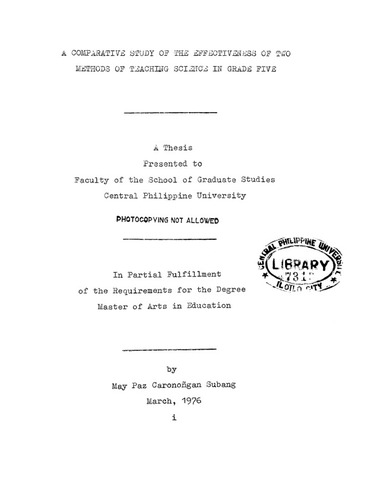A comparative study of the effectiveness of two methods of teaching science in grade five
| dc.contributor.adviser | Ruiz, Macario B. | |
| dc.contributor.author | Subang, May Paz Caronoñgan | |
| dc.date.accessioned | 2021-10-18T06:35:33Z | |
| dc.date.available | 2021-10-18T06:35:33Z | |
| dc.date.issued | 1976 | |
| dc.identifier.citation | Subang, M. P. C. (1976). A comparative study of the effectiveness of two methods of teaching science in grade five (Unpublished Master’s thesis). Central Philippine University, Jaro, Iloilo City. | en_US |
| dc.identifier.uri | https://hdl.handle.net/20.500.12852/1587 | |
| dc.description | Introduction and statement of the problem | en_US |
| dc.description.abstract | An efficient teacher should be aware of the new teaching procedures or strategies which could achieve the best results in the teaching-learning process. By "best results” is meant that his pupils should show that they have fully attained the goals set for them in the course. To attain this objective, the teacher should adopt the method or procedure which would help his pupils develop to their fullest capacity and show a remarkably high academic achievement, as well as develop the skills expected of them as minimum requirements in the grade they are in. The purpose of this study is to discover such effective methods of teaching by comparing the academic achievement of grade five pupils who were taught through "process approach" with that of comparable pupils who were taught under the traditional method. The researcher would like the experiment to answer the following questions: (1) Which of the two methods, "process approach or traditional method, will produce better results in the teaching-learning situation? In other words, which of the two groups will show higher achievement in science only, the experimental group using the "process approach" or the control group using the traditional method? (2) Which method will be better to use for the superior group? (3) Which one will be better for the slower group? The effectiveness of the method should be measured in terms of significantly higher achievement of a group of pupils taught under one of the methods, after two equated groups have taken the same subject matter and been given a common or the same achievement test. The null hypothesis adopted at the start of the experiment was that there was no significant difference between the results from the two methods of teaching Grade V science units. | en_US |
| dc.format.extent | 193 leaves | en_US |
| dc.language.iso | en | en_US |
| dc.subject.ddc | GSL Theses 378.242 Su14 | en_US |
| dc.subject.lcsh | Science--Study and teaching (Elementary) | en_US |
| dc.subject.lcsh | Teaching--Methodology | en_US |
| dc.title | A comparative study of the effectiveness of two methods of teaching science in grade five | en_US |
| dc.title.alternative | A comparative study of the effectiveness of two methods of teaching science in grade 5 | en_US |
| dc.type | Thesis | en_US |
| dc.description.bibliographicalreferences | Includes bibliographical references | en_US |
| dc.contributor.chair | Griño, Eliza U. | |
| dc.contributor.committeemember | Alba, Leda G. | |
| dc.contributor.committeemember | Padernilla, Evangelica D. | |
| dc.contributor.committeemember | Gobuyan, Cordelia A. | |
| dc.contributor.committeemember | Herradura, Elma S. | |
| dc.contributor.committeemember | Tabaldo, Ana J. | |
| dc.contributor.department | School of Graduate Studies | en_US |
| dc.description.degree | Master of Arts in Education major in Administration and Supervision | en_US |
| local.relation.associatedcontent | https://repository.cpu.edu.ph/handle/20.500.12852/2182 Journal article published in Southeast Asia Journal | en |


